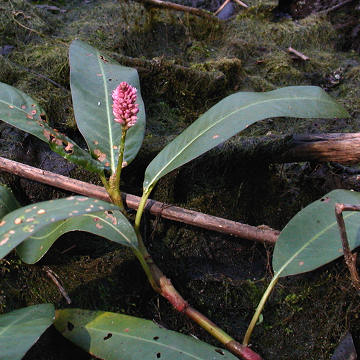

Polygonum amphibium - (image 1 of 5)
Taxonomy
Family: Polygonaceae
Habitat
Wet soil and shallow water of marshes, bogs, shores.
Associates
Distribution
Widespread in the Northern Hemisphere and in South Africa. Variety amphibium occurs only in Europe.
Morphology
Rhizomatous perennial, functionally dioecious; aquatic, emergent or terrestrial. Stems glabrous or pubescent, often branched, floating in aquatic forms, erect or ascending in terrestrial forms to 1 m. Leaves mainly cauline, alternate; terrestrial form with lance-acuminate, hairy leaves; aquatic forms with floating, glabrous, elliptic and obtuse or rounded leaves. Ocreae fringed or not, often with a flared collar in aerial forms. Flowers in stout, terminal, solitary or paired racemes, subtended by ocreolae (Section Persicaria); tepals 5, pink to reddish, rounded above, united below, 4-5 mm at anthesis; outer tepals not keeled or winged at maturity; styles short, withering in fruit.
Notes
Flowers June to October.
Wetland indicator: Obligate
The specific epithet refers to the phenotypic plasticity of this species in response to changes in water level. Two varieties are recognized in the northeastern U.S.:
var. stipulaceum N. Coleman is aquatic-adapted and will not flower when stranded, with inflorescences up to 4 cm and leaves that are glabrous, floating, and elliptic; stipules often with an herbaceous flange.
var. emersum Michx. is terrestrial or strongly emergent from shallow water, lacking floating leaves or shoots, with inflorescences 4-15 cm and glandular-hairy peduncles, and leaves that are hairy and acuminate, with stipules lacking an herbaceous flange. P. coccineum in Swink & Wilhelm would be referable to this variety.
References
Gleason, Henry A. and A. Cronquist. 1991. Manual of Vascular Plants of Northeastern United States and Adjacent Canada. Second Ed.
The New York Botanical Garden. Bronx, NY
Swink, F. and G. Wilhelm. 1994. Plants of the Chicago Region.
Indiana Academy of Science. The Morton Arboretum. Lisle, Illinois.
|
Michael Hough © 2009 |